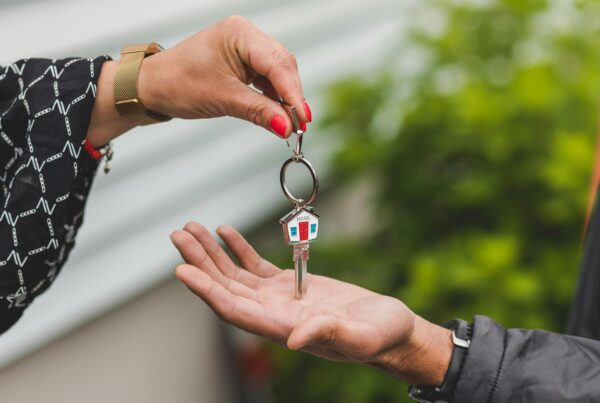Home equity can be a key metric when determining when it’s possible to pursue a cash-out refinance, home equity loan, or second mortgage. This equity is intricately connected to your loan-to-value ratio, which is the ratio between your current mortgage balance and your property’s appraised value.
Today, we’ll examine the facets of the loan-to-value ratio, how it relates to home equity, and how you can utilize this information to make smart financial decisions based on your home’s LTV ratio.
What is Home Equity Loan to Value Ratio?
Home equity refers to how much of the property you own outright instead of how much you are still paying off. It will go up as you continue to pay down your mortgage, but it can also rise due to market factors, as that increase in value would not have been originally covered by your loan.
The loan-to-value (LTV) is how much you owe on the home versus how much it is worth. This amount is what you originally took out as a loan minus what you have already paid. For example, if you took out a $260,000 loan and have paid off $30,000, your mortgage debt would be $230,000.
Bringing these together, the home equity loan to value (LTV) is the current loan balance divided by the home’s appraised value.
-
Why is LTV Important for Homeowners?
LTV ratios are crucial because they determine loan eligibility and set your monthly payments when you’re seeking a home equity loan. If you know how much home equity you have and the interest rates that mortgage lenders are willing to offer, you’ll be able to budget for your payments.
High LTV ratios may also mean that you require private mortgage insurance for home equity loans, so knowing when you’ll have enough equity to avoid PMI can also help reduce your costs.
Finally, LTV is important because you can only access certain loans if you have a low enough LTV. The lower your LTV, the more you will likely be able to receive from a new loan, as you will have more home equity available to use. This increased home equity makes you a more attractive borrower to lenders.
-
How to Calculate LTV Home Equity Loan Ratio?
To assess your LTV ratio, you will need your current loan balance and your home’s appraised value. You can find your loan balance by checking your monthly mortgage statement. This document will tell you your loan amount, how much you have paid, and how much you have left to pay.
For the home’s value, you can look at property values on sites like Zillow or Redfin. This will be a rougher estimate than a professional appraisal. It’s key to note that the appraisal value is different from the home’s current market value. The market value is what a potential buyer would be willing to pay and not necessarily the property value.
When you have this information, divide the loan balance by the home’s current appraised value, then multiply it by 100 to get a percentage. The formula looks like this:
(Balance/Value) x 100
To find how much equity you have, subtract the LTV percentage from 100 and multiply this by the full value of the home to give you a dollar amount.
Value x LTV ratio
-
Example of LTV
Assume you have a loan balance of $160,000 and your home’s current appraised value is $210,000. You’ll divide the balance by the value and multiply it by 100 to get the percentage. This number will help you estimate how much you can borrow in home equity loans.
($160,000/$210,000) x 100
Your LTV ratio is 76%, meaning you own 24% of your home outright.
You can now see your home’s equity in a dollar amount by multiplying this percentage by the home value.
$210,000 x 0.24
You have $50,400 in home equity. You can then use some of this to get a home equity line of credit or receive a lump sum for a cash-out refinance.
Meaning of LTV Ranges
The loan-to-value ratio identifies the amount you still have to pay on your loan and the amount of home equity you have.
A low LTV ratio means that you have more equity built up, while a high LTV ratio means that you have a higher loan amount to pay off and, thus, less equity.
-
What Is an Ideal LTV Percentage?
The ideal LTV percentage is 80%. If you are at or below this threshold, you will likely be approved for a home equity mortgage loan, while a higher LTV ratio may disqualify you.
This decision is because a higher LTV indicates that you’ve borrowed more against the value of your home. As a result, you will have a combined LTV based on both loans you have taken out. A higher LTV increases your risk of default, as your loan payments will be higher and your equity cushion smaller.
Factors Affecting Your LTV Home Equity Loan
Several factors impact your loan-to-value ratio and, therefore, your home equity. These include:
- Changes in Property Value – If your home has shot up in value, that will decrease your LTV, even if you have not paid any more on your mortgage loan.
- Loan Payments – Making regular mortgage payments reduces the principal balance of your loan. As you pay the principal, your LTV ratio decreases, increasing your home equity and potentially qualifying you for better loan terms.
- Additional Borrowing – Taking out additional loans, such as home equity loans or HELOCs, will increase your LTV ratio. This increment is because your combined loan-to-value ratio now includes your primary mortgage and the additional loans, making your overall debt higher than your home’s value.
What is a Home Equity Line of Credit (HELOC)?
Home equity lines of credit (HELOCs) are revolving credit accounts similar to credit cards. You have a set limit on how much you can borrow overall, and you can draw down cash as needed.
You’ll then pay back what you borrowed, just as you would a credit card balance, except the repayment period is longer. Generally, you can use your home equity line of credit for 10 years, and then you will enter the repayment period of the loan term, which can be as long as 20 years.
Many use home equity loans for home improvement projects or debt consolidation, such as paying off student loans or medical debt. Some may also use them for a down payment on a second home.
However, these are loans secured by your property rather than your credit score; essentially, you borrow money from your property’s home equity. If you misuse a HELOC, you risk losing your home.
As with your first mortgage, your ability to access home equity loans depends on your borrower profile. Most home equity lenders require a good credit score; some want one higher than typical for a first mortgage. You will also need a lower debt-to-income ratio, which is determined by dividing your debts by your gross monthly income.
Home equity loans often have a variable interest rate, though you can find options with a fixed interest rate. You will also need to pay closing costs, though there is no down payment.
When exploring how to refinance with home equity loans, decide which type of refinancing program is right for you and assess your financial goals so that you can use LTV home equity loans for optimum benefit.
Home Equity Loans During Homeownership Stages
Your ability to get an LTV home equity loan depends on what stage of ownership you are in, as this will determine the value of your loan.
-
Early Stage
During the first years of home ownership, you are unlikely to access home equity loans, as you will have a higher LTV ratio than most lenders would prefer. Instead of tapping into your home equity, focus on paying the principal and building more equity.
-
Mid-Stage
After owning your home for several years and paying down your principal, you will have a lower LTV ratio and more home equity. You can now begin exploring home equity loans and other options for your other financial goals.
This stage is also a great time to make any necessary home repairs and upgrades in preparation for refinancing or opening a HELOC later. Be strategic about how you update your home: some of the best options include improving its energy efficiency and adding accessibility upgrades.
-
Late-Stage
If you have owned your home for over a decade, you will have built up significant home equity and steadily paid down your mortgage. Your LTV will be much lower than it was at the start, especially if property values have risen in your area.
This stage is a great time to talk to a real estate professional and mortgage lender to explore your financing options, whether that is refinancing into a new mortgage or opening up a home equity line of credit to pay for other needs.
Pros of Low LTV Home Equity Loan
- Lower Interest Rates: If you have a stable income, a good borrower profile, and a low loan-to-value ratio, you will likely access better interest rates on home equity loans. This reduces the amount of interest you pay over the life of the loan, saving you money.
- Access to HELOC for Home Improvement: A low LTV ratio allows you to seek out a home equity loan to finance your home improvement projects, allowing you to fund renovations and potentially increase the value of your home.
- Stronger Bargaining Position When Selling: A low LTV ratio puts you in a more advantageous position when selling your home. Lenders view you as less of a risk, which can lead to better loan terms and more options.
Cons of High Home Equity LTV
- Limited Access to Loan Options: A high loan-to-value (LTV) ratio can restrict your access to additional financing. Many lenders require a maximum LTV of no more than 85% to qualify for a home equity loan.
- Difficulty Securing Favorable Interest Rates: Even if you can secure a home equity loan with a high LTV, the interest rates will likely be higher. This increased interest rate will result in higher overall costs over the life of the loan, making it more expensive in the long run.
- Risk of Negative Equity: A high LTV ratio increases the risk of falling into negative equity if the market value of your home decreases. Negative debt occurs when your outstanding loan balance exceeds the value of your home, making it difficult to refinance or sell your property without incurring a loss.
- Alternative Financing Challenges: If your home’s equity is too low, you may need to seek alternative financing options such as personal loans. These loans often have higher interest rates and less favorable terms than home equity loans.
LTV Ratio Variations Based on Loan Type
The maximum loan-to-value (LTV) possible for your first mortgage depends significantly on the loan type you choose. These are some of the high LTV loan options that you may consider if you don’t have a large amount to put down at the start of your mortgage.
High LTV home equity loans are available in some cases, but they are less common than primary loans and have fewer upfront costs.
-
Adjustable-Rate Loans
Adjustable-rate loans allow for a maximum loan-to-value of 95%, making them a good option for those who do not have significant cash reserves but expect to have significantly more income in the future. Variable-rate loans typically have a fixed rate at the beginning, which will then adjust to market conditions after 5, 7, or 10 years.
To refinance these products, you must provide up to 20% down on the refinance to bring your LTV down to 80%.
-
VA Loans
VA loans offer a 100% LTV for a cash-out refinance, though you can often access better rates if you provide a down payment. This product is better than even FHA loans, which require a maximum LTV of 96.5%.
It’s important to note that VA loans are exclusively for veterans, and there are strict stipulations to access this type of home loan. Our loan officers can help you determine eligibility and apply for your Certificate of Eligibility, which is a key document when applying for a VA loan.
-
Fannie Mae and Freddie Mac
In some cases, Fannie Mae and Freddie Mac will allow an LTV of up to 97%. You will need to prove that the refinance will assist you, such as reducing your loan term and monthly payments or refinancing into a fixed-rate loan. There is also a 15-month seasoning period, meaning you cannot refinance right away.
Strategies to Optimize Your LTV Home Equity Loan
Your LTV is a key facet of your financial health, as it determines how quickly you can pay off your loan and whether you can access a home equity loan. Follow these strategies to boost your LTV ratio, offering yourself more options in terms of other financing.
-
Consistent Mortgage Payments
The most crucial way to lower your LTV ratio is simply to make your monthly payments on time. Depending on your mortgage, you can also pay ahead, which will help you build equity faster and reduce the interest you pay over time.
-
Property Improvements and Renovations
Another strategy is to make key home improvements, as this will improve your home’s property value. High-impact renovations, such as rehauling the kitchen or adding a new room, can have a high return on investment that will quickly show when you get a new appraisal.
A home improvement project may also provide tax benefits, depending on what kind of project you undertake. Improving energy efficiency and providing greater accessibility, such as adding ramps or guardrails, can be deducted from your tax bill, which will help reduce the financial burden of making the improvements.
-
Market Appreciation
You can let the market raise your LTV ratio for you. By continuing to make payments and allowing your property to appreciate, you will boost its value and lower the loan-to-value ratio without making any improvements.
If you choose to open a home equity line of credit, you’ll then be able to access more funding because the combined LTV ratio will be lower.
Summary
A home equity loan can be a vital tool in gaining funding for other needs, such as fixing up your home or paying down other debts. F5 Mortgage is here to assist you with all of your mortgage needs, including refinancing.
Contact us today and speak to an expert about your refinancing options, or get a free quote to see how much you could save through a refinance. You can also check out today’s rates to see what you can afford should you refinance your home.
FAQs
How Often Should I Calculate My LTV Home Equity Loan?
You should assess your home’s LTV ratio at least once a year using estimation tools like Zillow or Redfin.
However, if you are considering a home equity line of credit, getting a professional appraisal is the best option, as this will ensure that you have the most accurate estimation of your home’s worth and hit the standards that loan officers require.
Does My LTV Decrease Over Time?
Yes, your LTV will decrease over time as you continue to pay off your loan. So even if your property values stay the same, you will still have less borrowed than when you began. If your home’s value rises, your LTV will decrease even further.
Is There an Ideal LTV?
The ideal LTV is considered 80%. If your LTV is lower than this, you are highly qualified for a home equity loan and will be able to access great interest rates. Continue to pay off your mortgage over time and make smart home upgrades to push your loan-to-value ratio down even further.








